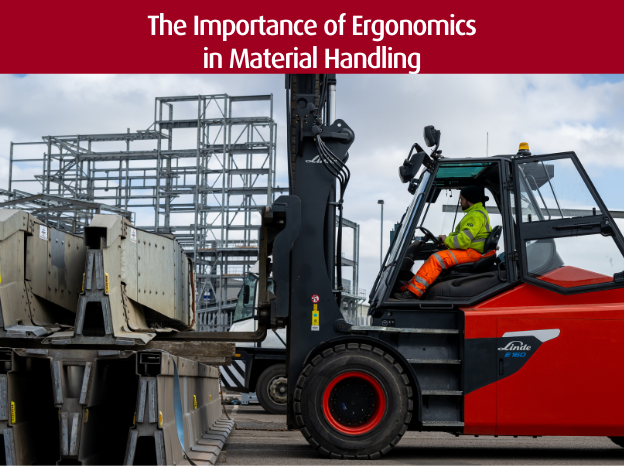Did you know that musculoskeletal disorders (MSDs) from poor ergonomics in material handling cost businesses billions annually in lost productivity and healthcare expenses?
In today’s fast-paced industrial environment, ergonomics plays a pivotal role in ensuring the safety, efficiency, and well-being of workers. Material handling, in particular, presents unique challenges, as it involves lifting, carrying, and maneuvering heavy loads that can strain the body over time.
Integrating ergonomic principles into material handling not only enhances worker comfort but also boosts productivity and reduces the risk of injuries. This article sums up why ergonomics is crucial in material handling and how companies can benefit from a more ergonomically designed workplace.
What is Ergonomics in Material Handling?
Ergonomics refers to the science of designing workstations, tools, and tasks that fit the human body’s natural movements and capabilities. In the context of material handling, ergonomics focuses on minimizing physical strain and promoting safe movement while handling goods. This is particularly important in warehouses and manufacturing facilities, where improper techniques or equipment can lead to musculoskeletal disorders (MSDs), fatigue, and injuries.
When workers are required to handle heavy loads or operate machinery repetitively, there is a higher risk of strain-related injuries. In fact, MSDs are one of the most common causes of absenteeism in material handling sectors. These injuries not only impact worker health but can also result in increased operational costs due to lost workdays, medical expenses, and reduced productivity.
The Physical Demands of Material Handling
Material handling is a physically demanding task. Workers often have to lift, push, pull, or carry heavy objects, sometimes in incorrect postures. Repetitive movements and prolonged periods of standing and incorrect postures can lead to strain on the back, shoulders, neck, and arms. Key risks associated with poor ergonomics for material handling workers include:
- Back pain and injuries from lifting heavy objects improperly
- Shoulder and arm strain from repetitive motions
- Fatigue from prolonged standing or working in non-optimal postures
- Hand and wrist injuries from operating tools or machinery without ergonomic design
The Benefits of Ergonomics in Material Handling
Investing in ergonomically designed equipment and workspaces offers several benefits:
- Improved Worker Safety: The primary goal of ergonomics is to reduce the risk of injury. Properly designed equipment and workstations allow workers to maintain good posture, minimize repetitive movements, and reduce strain on muscles and joints. This not only prevents injuries but also fosters a safer working environment.
- Increased Productivity: When workers are comfortable and safe, they can perform their tasks more efficiently. Ergonomics reduces the physical burden on workers, allowing them to work faster and with greater precision. This leads to fewer mistakes, less fatigue, and higher overall productivity.
- Reduced Costs: Workplace injuries, particularly those related to musculoskeletal disorders, can lead to costly medical treatments, compensation claims, and lost workdays. By prioritizing ergonomics, companies can significantly reduce the financial burden associated with these injuries. Additionally, efficient workers contribute to lower operational costs and improved workflow.
- Enhanced Job Satisfaction: Ergonomics contributes to a better working environment, which can lead to higher job satisfaction. Workers who feel safe and comfortable are more likely to remain engaged and motivated in their roles. This can also help reduce employee turnover and improve overall morale.
- Better Operational Efficiency: An ergonomically optimized workplace can streamline operations by minimizing unnecessary movements and improving the layout of workspaces. This ensures that workers can complete tasks more efficiently, leading to faster turnaround times and smoother workflows.
Implementing Ergonomics in Material Handling
To fully realize the benefits of ergonomics in material handling, there’s a need for companies to assess current practices and identify areas for improvement. Here are some strategies to incorporate ergonomic principles into material handling:
- Use of Ergonomically Designed Equipment: This is one of the most important things to be considered while implementing ergonomics in material handling. Investing in modern, ergonomically designed material handling equipment such as new age forklifts, pallet jacks, and lift-assist devices can significantly reduce strain on workers. For example, forklifts with adjustable seats, easy-to-reach controls, and proper steering mechanisms help operators maintain comfort during long shifts.
- Proper Training: Workers should receive comprehensive training on ergonomic practices, such as proper lifting techniques, posture alignment, and how to operate equipment safely. Training empowers workers to perform their jobs with minimal physical strain, reducing the risk of injury.
- Task Rotation: Rotating workers between tasks that involve different physical demands can help reduce the risk of repetitive strain injuries. Task rotation allows muscles to rest and recover, preventing overuse and fatigue.
- Regular Health and Safety Audits: Regularly assessing workplace ergonomics through health and safety audits can help identify areas for improvement. These audits should evaluate the physical demands placed on workers and ensure that equipment and workstations meet ergonomic standards.
The Future of Ergonomics in Material Handling
As industries continue to evolve, so do the technologies and practices that support ergonomic material handling. Automation, for example, is playing an increasingly important role in reducing the physical burden on workers. Automated guided vehicles can handle heavy loads and repetitive tasks, allowing workers to focus on less physically demanding tasks.
Conclusion
Ergonomics is a critical component of material handling, directly impacting worker safety, productivity, and operational efficiency. By adopting ergonomic practices and investing in modern equipment, companies can create a healthier, more efficient work environment.
For businesses looking to enhance their material handling operations, Linde offers a range of ergonomic solutions designed to promote worker comfort and safety. Whether you need forklifts or warehouse equipment, Linde’s innovative solutions are built with the user in mind. Contact us at 1800 270 1123 or visit www.lindemhe.com to learn more about our offerings and take the first step toward a safer and more efficient future.
